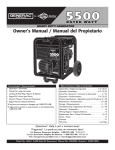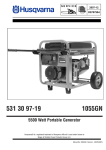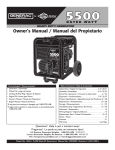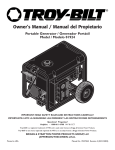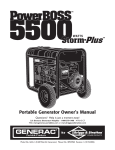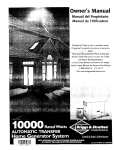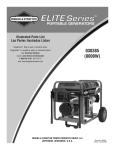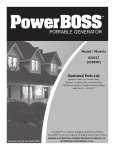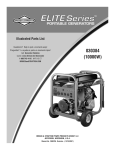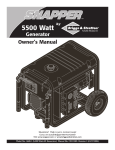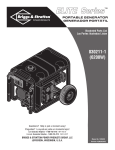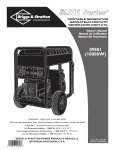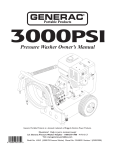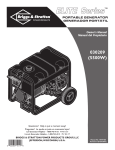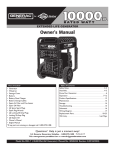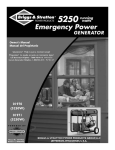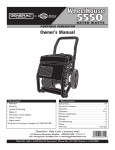Download Husqvarna 1365GN User's Manual
Transcript
01935 1365GN Owner’s Manual Read this manual carefully and become familiar with your generator. Know the applications, the limitations and any hazards involved. [193174GS Rev 0a (06/01/04)] Part Number 531 30 00-69 Safety Rules TABLE OF CONTENTS SAFETY RULES Safety Rules. . . . . . . . . . . . . . . . . . . . . . . . . . . . . . . . . . 2-4 Know Your Generator . . . . . . . . . . . . . . . . . . . . . . . . . . . 5 Assembly. . . . . . . . . . . . . . . . . . . . . . . . . . . . . . . . . . . . 6-7 Operation . . . . . . . . . . . . . . . . . . . . . . . . . . . . . . . . . . 8-13 Maintenance . . . . . . . . . . . . . . . . . . . . . . . . . . . . . . . . . . 14 Storage . . . . . . . . . . . . . . . . . . . . . . . . . . . . . . . . . . . . . . 15 Notes . . . . . . . . . . . . . . . . . . . . . . . . . . . . . . . . . . . . . . . 16 Troubleshooting . . . . . . . . . . . . . . . . . . . . . . . . . . . . . . . 17 Schematic/ Wiring Diagram . . . . . . . . . . . . . . . . . . . . 18-19 Replacement Parts. . . . . . . . . . . . . . . . . . . . . . . . . . . 20-24 Warranty . . . . . . . . . . . . . . . . . . . . . . . . . . . . . . . . . . . . 25 This is the safety alert symbol. It is used to alert you to potential personal injury hazards. Obey all safety messages that follow this symbol to avoid possible injury or death. The safety alert symbol ( ) is used with a signal word (DANGER, CAUTION,WARNING), a pictorial and/or a safety message to alert you to hazards. DANGER indicates a hazard which, if not avoided, will result in death or serious injury. WARNING indicates a hazard which, if not avoided, could result in death or serious injury. CAUTION indicates a hazard which, if not avoided, might result in minor or moderate injury. CAUTION, when used without the alert symbol, indicates a situation that could result in equipment damage. Follow safety messages to avoid or reduce the risk of injury or death. EQUIPMENT DESCRIPTION Read this manual carefully and become familiar with your generator. Know the applications, the limitations and any hazards involved. This generator is an engine–driven, revolving field, alternating current (AC) generator. It was designed to supply electrical power for operating compatible electrical lighting, appliances, tools and motor loads.The generator’s revolving field is driven at about 3,600 rpm by a singlecylinder engine. WARNING The engine exhaust from this product contains chemicals known to the State of California to cause cancer, birth defects, or other reproductive harm. Hazard Symbols and Meanings CAUTION! DO NOT exceed the generator’s wattage/amperage capacity. See “Don’t Overload Generator” on page 13. Every effort has been made to ensure that information in this manual is accurate and current. However, we reserve the right to change, alter or otherwise improve the product and this document at any time without prior notice. Electrocution The Emission Control System for this generator is warranted for standards set by the Environmental Protection Agency. For warranty information refer to the engine owner’s manual. Toxic Fumes In the State of California a spark arrester is required by law (Section 4442 of the California Public Resources Code). Other states may have similar laws. Federal laws apply on federal lands.The muffler is equipped with a spark arrester; it must be maintained in effective working order. Replacement spark arresters may be obtained by calling 1-877-224-0458. Explosive Pressure 2 Electrical Shock Explosion Chemical Burn Electrical Shock Fire Hot Surface Safety Rules DANGER DANGER Storage batteries give off explosive hydrogen gas during recharging. Hydrogen gas stays near battery for a long time after battery has been charged. Slightest spark will ignite hydrogen and cause explosion. You can be blinded or severely injured. Battery electrolyte fluid contains acid and is extremely caustic. Contact with battery fluid will cause severe chemical burns. Running generator gives off carbon monoxide, an odorless, colorless, poison gas. Breathing carbon monoxide will cause nausea, fainting or death. • Operate generator ONLY outdoors. • Keep at least 2 feet of clearance on all sides of generator for adequate ventilation. • DO NOT operate generator inside any building or enclosure, including the generator compartment of a recreational vehicle (RV). DANGER • DO NOT allow any open flame, spark, heat, or lit cigarette during and for several minutes after charging a battery. • Wear protective goggles, rubber apron, and rubber gloves. Failure to properly ground generator can result in electrocution, especially if the generator is equipped with a wheel kit. • National Electric Code requires generator to be properly grounded to an approved earth ground. Call an electrician for local grounding requirements. WARNING Fuel and its vapors are extremely flammable and explosive. Fire or explosion can cause severe burns or death. DANGER Generator produces powerful voltage. Failure to isolate generator from power utility can result in death or injury to electric utility workers due to backfeed of electrical energy. WHEN ADDING FUEL: • Turn generator OFF and let it cool at least 2 minutes before removing gas cap. Loosen cap slowly to relieve pressure in tank. • When using generator for backup power, notify utility company. Use approved transfer equipment to isolate generator from electric utility. • Use a ground fault circuit interrupter (GFCI) in any damp or highly conductive area, such as metal decking or steel work. • DO NOT touch bare wires or receptacles. • DO NOT use generator with electrical cords which are worn, frayed, bare or otherwise damaged. • DO NOT operate generator in the rain or other forms of precipitation. • DO NOT handle generator or electrical cords while standing in water, while barefoot, or while hands or feet are wet. • DO NOT allow unqualified persons or children to operate or service generator. • Fill fuel tank outdoors. • DO NOT overfill tank. Allow space for fuel expansion. • Keep fuel away from sparks, open flames, pilot lights, heat, and other ignition sources. • DO NOT light a cigarette or smoke. WHEN OPERATING EQUIPMENT: • DO NOT tip engine or equipment at angle which causes fuel to spill. • This generator is not for use in mobile equipment or marine applications. WHEN TRANSPORTING OR REPAIRING EQUIPMENT: • Transport/repair with fuel tank EMPTY or with fuel shutoff valve in the OFF position. WARNING • Disconnect spark plug wire. WHEN STORING FUEL OR EQUIPMENT WITH FUEL IN TANK: • This generator does not meet U. S. Coast Guard Regulation 33CFR-183 and should not be used on marine applications. • Failure to use the appropriate U. S. Coast Guard approved generator could result in bodily injury and/or property damage. • Store away from furnaces, stoves, water heaters, clothes dryers or other appliances that have pilot light or other ignition source because they can ignite fuel vapors. 3 Safety Rules CAUTION WARNING Exceeding generator’s wattage/amperage capacity can damage generator and/or electrical devices connected to it. Unintentional sparking can result in fire or electric shock. • See “Don’t Overload Generator” on page 13. • Start generator and let engine stabilize before connecting electrical loads. • Connect electrical loads in OFF position, then turn ON for operation. • Turn electrical loads OFF and disconnect from generator before stopping generator. WHEN ADJUSTING OR MAKING REPAIRS TO YOUR GENERATOR • Disconnect the spark plug wire from the spark plug and place the wire where it cannot contact spark plug. WARNING CAUTION Running engines produce heat.Temperature of muffler and nearby areas can reach or exceed 150°F (65°C). Severe burns can occur on contact. Improper treatment of generator can damage it and shorten its life. • Use generator only for intended uses. • If you have questions about intended use, ask your Husqvarna dealer or contact customer service at 1-877-224-0458. • Operate generator only on level surfaces. • DO NOT expose generator to excessive moisture, dust, dirt, or corrosive vapors. • DO NOT insert any objects through cooling slots. • If connected devices overheat, turn them off and disconnect them from generator. • Shut off generator if: -electrical output is lost; -equipment sparks, smokes, or emits flames; -unit vibrates excessively. • DO NOT touch hot surfaces. • Allow equipment to cool before touching. CAUTION Excessively high operating speeds increase risk of injury and damage to generator. Excessively low speeds impose a heavy load. • DO NOT tamper with governed speed. Generator supplies correct rated frequency and voltage when running at governed speed. • DO NOT modify generator in any way. 4 Features and Controls KNOW YOUR GENERATOR Read this owner’s manual and safety rules before operating your generator. Compare the illustrations with your generator, to familiarize yourself with the locations of various controls and adjustments. Save this manual for future reference. Recoil Starter Engine Switch Oil Fill Fuel Tank Choke Lever Hour Meter 12 Volt DC,10 Amp Receptacle Air Cleaner Idle Control Switch 120 Volt AC, 20 Amp GFCI Duplex Receptacles Spark Arrester Muffler Circuit Breakers (AC) 120/240 Volt AC, 30 Amp Receptacle Grounding Fastener 12 Volt DC,10 Amp Receptacle — Recharge a discharged 12 Volt automotive type battery through this receptacle. 120 Volt AC, 20 Amp GFCI Duplex Receptacles — May be used to supply electrical power for the operation of 120 Volt AC, 20 Amp, single phase, 60 Hz electrical, lighting, appliance, tool and motor loads. 120/240 Volt AC, 30 Amp Locking Receptacle — May be used to supply electrical power for the operation of 120 and/or 240 Volt AC, 30 Amp, single phase, 60 Hz electrical, lighting, appliance, tool and motor loads. Air Cleaner — Uses a dry type filter element to limit the amount of dirt and dust sucked into the engine. Choke Lever — Used when starting a cold engine. Circuit Breakers (AC) — Push to reset circuit breakers are provided to protect the generator against electrical overload. Fuel Tank — Capacity of seven (7) U.S. gallons. Grounding Fastener — Contact your local electrician for grounding requirements (see page 8). Hour Meter — Displays and records how many hours your generator has run (up to 9,999.9). Idle Control Switch — The idle control runs the engine at normal (high) speeds when there is a load present and runs the engine at idle (low) speeds when a load is not present. Oil Fill — Add engine oil here. Recoil Starter — Used to start the engine. Engine Switch — Set this switch to "On" before using recoil starter. Set switch to "Off" to switch off engine. Spark Arrester Muffler — Exhaust muffler lowers engine noise and is equipped with a spark arrester screen. 5 Assembly ASSEMBLY Carton Contents Check all contents. If any parts are missing or damaged, call the generator helpline at 1–877–224–0458. Your generator requires some assembly and is ready for use after it has been properly serviced with the recommended oil and fuel. • The generator • Generator and engine owner’s manuals If you have any problems with the assembly of your generator, please call the generator helpline at 1–877–224–0458. • Locking 30 Amp plug • Battery charge cables • Engine oil Remove Generator From Carton 1. Set carton on a rigid flat surface with “This Side Up” arrows pointing upward. 2. Carefully open top flaps of shipping carton. 3. Cut down corners at one end of carton from top to bottom and lay that side of carton down flat. 4. Remove all packing material, carton fillers, etc. 5. Remove generator from shipping carton. • Wheel kit Install Wheel Kit The wheel kit is designed to greatly improve the portability of your generator. NOTE: Wheel kit is not intended for over-the-road use. You will need a socket wrench with 1/2" or 13mm sockets and a needle-nose pliers to install this kit. Refer to Figure 1 and install the wheel kit as follows: 1. Place the bottom of the generator frame on a flat, even surface.Temporarily place unit on blocks to ease assembly. Figure 1 — Install Wheel Kit Handle Pin Nylon Washer Nylon Washer 45 mm Cap Screw Flat Washer Handle Wheel Nut Flat Washer Use existing hardware to attach left side of support leg to unit Axle Nut Support Leg 20 mm Cap Screw E-Ring Vibration Mount 3/4” Cap Screw Nut 6 Assembly 2. Slide axle through both axle mounting brackets on cradle frame, as shown in Figure 1. 3. Slide a wheel over the axle. BEFORE STARTING THE ENGINE NOTE: Be sure to install both wheels with the air pressure valve on the outboard side. Add Engine Oil and Fuel 4. • Place generator on a level surface. Place the e-ring onto the groove in the axle.You may add the flat washer if desired. • Refer to engine owner’s manual and follow oil and fuel recommendations and instructions. NOTE: Use retaining pins instead of e-clip, if applicable. 5. Place one end of the needle nose pliers on the bottom of the axle and the other end of the pliers on top of the e-ring. Seat the e-ring by pressing the pliers closed. 6. Repeat step 3 through 5 to secure second wheel. 7. Remove the temporary blocks. 8. Attach the vibration mounts to the support leg with 3/4” capscrews and lock nuts. 9. To aid support leg assembly, rest generator on cradle, engine end down. Remove the existing hardware from the left unit vibration mount with 13mm wrench. Use the same hardware to attach the support leg. CAUTION Any attempt to crank or start the engine before it has been properly filled with the recommended oil will result in equipment failure. • Refer to engine manual for oil and fuel fill information. • Damage to equipment resulting from failure to follow this instruction will void warranty. NOTE: Check oil often during engine break–in. Refer to engine owner’s manual for recommendations. NOTE: The generator assembly rotates on a prelubricated and sealed ball bearing that requires no additional lubrication for the life of the bearing. 10. Attach the other side of the support leg with a 20 mm cap screw and lock nut. Rest generator on wheels and support leg. 11. Attach handles to handle brackets on generator frame, as shown in Figure 1, with 45 mm capscrews, flat washers, nylon washers, and lock nuts. 12. Loop handle pins to generator frame as shown in Figure 1. Raise handles and insert handle pins to move generator. 13. Check each fastener to ensure it is secure and the tires are inflated between 15-40 PSI. 7 Operation GROUNDING THE GENERATOR OPERATING THE GENERATOR CAUTION The National Electrical Code requires that the frame and external electrically conductive parts of this generator be properly connected to an approved earth ground. Local electrical codes may also require proper grounding of the unit. For that purpose, a GROUNDING FASTENER is provided on the generator end (Figure 2). Exceeding generator’s wattage/amperage capacity can damage generator and/or electrical devices connected to it. • See “Don’t Overload Generator” on page 13. • Start generator and let engine stabilize before connecting electrical loads. • Connect electrical loads in OFF position, then turn ON for operation. • Turn electrical loads OFF and disconnect from generator before stopping generator. Figure 2 — Grounding Fastener Starting the Engine Disconnect all electrical loads from the generator. Use the following start instruction steps by numerical order: Grounding Fastener 1. Make sure unit is on a level surface. IMPORTANT: Failure to start and operate unit on a level surface will cause the unit not to start or shut down during operation. Generally, connecting a No. 12 AWG (American Wire Gauge) stranded copper wire to the grounding fastener and to an earth–driven copper or brass grounding rod (electrode) provides adequate protection against electrical shock. Be careful to keep the grounding wire attached after connecting the stranded copper wire. However, local codes may vary widely. Consult with a local electrician for grounding requirements in your area. 2. Turn fuel valve to “On” position (Figure 3).The fuel valve handle should be vertical (pointing toward ground) for fuel to flow. Figure 3 — Fuel Valve Properly grounding the generator helps prevent electrical shock if a ground fault condition exists in the generator or in connected electrical devices, especially when the unit is equipped with a wheel kit. Proper grounding also helps dissipate static electricity, which often builds up in ungrounded devices. Fuel Valve is shown in the “On” position 3. Make sure Idle Control switch is in “Off” position (Figure 4). Figure 4 — Idle Control Switch 8 Operation 4. Charging a Battery Start engine according to instructions given in engine owner’s manual. Your generator has the capability of recharging a discharged 12 Volt automotive or utility style storage battery. DO NOT use the unit to charge any 6 Volt batteries. DO NOT use the unit to crank an engine having a discharged battery. NOTE: If engine starts after 3 pulls but fails to run, or if unit shuts down during operation, make sure unit is on a level surface and check for proper oil level in crankcase. This unit may be equipped with a low oil protection device. See engine manual. DANGER Storage batteries give off explosive hydrogen gas during recharging. Hydrogen gas stays near battery for a long time after battery has been charged. Slightest spark will ignite hydrogen and cause explosion. You can be blinded or severely injured. Battery electrolyte fluid contains acid and is extremely caustic. Contact with battery fluid will cause severe chemical burns. Connecting Electrical Loads • Let engine stabilize and warm up for a few minutes after starting. • Plug in and turn on the desired 120 and/or 240 Volt AC, single phase, 60 Hz electrical loads. • DO NOT connect 240 Volt loads to the 120 Volt duplex receptacles. • DO NOT connect 3–phase loads to the generator. • DO NOT connect 50 Hz loads to the generator. • DO NOT allow any open flame, spark, heat, or lit cigarette during and for several minutes after charging a battery. • Wear protective goggles, rubber apron, and rubber gloves. • DO NOT OVERLOAD THE GENERATOR. See “Don’t Overload Generator” on page 13. Stopping the Engine 1. Unplug ALL electrical loads from generator panel receptacles. NEVER start or stop engine with electrical devices plugged in and turned ON. 2. Move idle control switch to “Off” position. 3. Let engine run at no-load for several minutes to stabilize internal temperatures of engine and generator. 4. Turn engine off according to instructions given in the engine owner’s manual. 5. Move fuel valve to “Off” position. To recharge 12 Volt batteries, proceed as follows: 1. Check fluid level in all battery cells. If necessary, add ONLY distilled water to cover separators in battery cells. DO NOT use tap water. 2. If battery is equipped with vent caps, make sure they are installed and are tight. If necessary, clean battery terminals. Connect battery charge cable connector plug to panel receptacle identified by the words “12-VOLTS D.C.”. 3. 4. 5. Operating Automatic Idle Control Connect battery charge cable clamp with red handle to the positive (+) battery terminal (Figure 5). Figure 5 — Battery Connections This switch is designed to greatly improve fuel economy. When this switch is turned ON, the engine will only run at its normal high governed engine speed when an electrical load is connected.When an electrical load is removed, the engine will run at a reduced speed. With the switch off, the engine will run at the normal high engine speed. Always have the switch off when starting and stopping the engine. 9 Operation 6. Connect battery charge cable clamp with black handle to the negative (–) battery terminal (Figure 5). 7. Start engine. Let engine run while battery recharges. 8. When battery has charged, shut down engine Figure 6 — Permanent Cold Weather Shelter Wind NOTE: Use an automotive hydrometer to test battery state of charge and condition. Follow the hydrometer manufacturer’s instructions carefully. Generally, a battery is considered to be at 100% state of charge when specific gravity of its fluid (as measured by hydrometer) is 1.260 or higher. COLD WEATHER OPERATION 2. Under certain weather conditions (temperatures below 40°F [4°C] and a high dew point), your generator may experience icing of the carburetor and/or the crankcase breather system. 3. 4. Build a structure that will enclose three sides and the top of the generator: 1. Ensure a minimum of two feet clearance between open side of box and nearest object. Face exposed end away from wind and elements. Enclosure should hold enough heat created by generator to prevent problems. DANGER Running generator gives off carbon monoxide, an odorless, colorless, poison gas. Breathing carbon monoxide will cause nausea, fainting or death. Make sure entire muffler-side of generator is exposed. Note that your generator may appear different from that shown in Figure 6. • Operate generator ONLY outdoors. • Keep at least 2 feet of clearance on all sides of generator for adequate ventilation. • DO NOT operate generator inside any building or enclosure, including the generator compartment of a recreational vehicle (RV). • Remove generator from shelter when temperature is above 40°F [4°C]. 10 Operation RECEPTACLES 120 Volt AC, 20 Amp, GFCI Duplex Receptacles CAUTION Each duplex receptacle (Figure 8) is protected against overload by a push–to–reset circuit breaker. Receptacles may be marked with rating value greater than generator output capacity. Figure 8 — 120 Volt, 20 Amp GFCI Duplex Receptacle • NEVER attempt to power a device requiring more amperage than generator or receptacle can supply. • DO NOT overload the generator. See “Don’t Overload Generator”. 120/240 Volt AC, 30 Amp, Locking Receptacle Use a NEMA L14–30 plug with this receptacle. Connect a 4–wire cord set rated for 250 Volt AC loads at 30 Amps (or greater) (Figure 7).You can use the same 4–wire cord if you plan to run a 120 Volt load. Figure 7 — 120/240 Volt AC, 30 Amp Receptacle 4-Wire Cord Set Use each receptacle to operate 120 Volt AC, single–phase, 60 Hz electrical loads requiring up to 2,400 watts (2.4 kW) at 20 Amps of current. Use cord sets that are rated for 125 Volt AC loads at 20 Amps (or greater). 240V 120V 120V W (Neutral) 12 Volt DC, 10 Amp Receptacle This receptacle (Figure 9) allows you to recharge a 12 Volt automotive or utility style storage battery with the battery charge cables provided. Y (Hot) NEMA L14-30 Figure 9 — 12 Volt DC, 10 Amp Receptacle X (Hot) Ground (Green) This receptacle powers 120/240 Volt AC, 60 Hz, single phase loads requiring up to 6,500 watts of power (6.5 kW) at 30 Amps for 120 Volts or 240 Volts.The outlet is protected by a push–to–reset circuit breaker. This receptacle can not recharge 6 Volt batteries and can not be used to crank an engine having a discharged battery. See “Charging a Battery” on page 9 before attempting to recharge a battery.This outlet is protected by a 10 Amp self-resetting circuit breaker. 11 Operation Ground Fault Protection Testing the GFCI This unit is equipped with a Ground Fault Circuit Interrupter (GFCI).This device meets applicable federal, state and local codes. Test your GFCI outlet every month and before use, as follows: • Push the black “Test” button.The red “Reset” button should pop out, which should allow no power to reach the outlet. Use a test lamp in each outlet to test this. The GFCI protects against electrical shock that may be caused if your body becomes a path which electricity travels to reach the ground.This could happen if you touch a “Live” appliance or wire, or are touching plumbing or other materials that connect to the ground. CAUTION The “Reset” button does not pop out or the test lamp remains lit when the “Reset” button is popped out. When protected by a GFCI, one may still feel a shock, but the GFCI should cut current off quickly enough so that a person in normal health should not suffer any serious electrical injury. • DO NOT use any outlets on the circuit. • Call a qualified electrician. • If the GFCI tests good, restore power by pressing the “Reset” button firmly until it is fully in place and locks in that position. If the GFCI outlet does not reset properly, do not use the outlet. Call a local service center. DANGER Generator produces powerful voltage. • If the GFCI trips by itself at any time, reset and test the outlet. If the reset button does pop out when the test button is pressed, do not use the outlet. Call a local service center. • The GFCI will not protect you against the following situations: -Line-to-line shocks; -Current overloads or line-to-line short circuits. • The fuse or circuit breaker at the control panel must provide such protection. 12 Operation DON'T OVERLOAD GENERATOR 4. Plug in and turn on the next load. 5. Again, permit the generator to stabilize. 6. Repeat steps 4 and 5 for each additional load. NEVER add more loads than the generator capacity.Take special care to consider surge loads in generator capacity, as described above. Capacity You must make sure your generator can supply enough rated (running) and surge (starting) watts for the items you will power at the same time. Follow these simple steps: 1. Select the items you will power at the same time. 2. Total the rated (running) watts of these items.This is the amount of power your generator must produce to keep your items running. See Figure 10. 3. Estimate how many surge (starting) watts you will need. Surge wattage is the short burst of power needed to start electric motor-driven tools or appliances such as a circular saw or refrigerator. Because not all motors start at the same time, total surge watts can be estimated by adding only the item(s) with the highest additional surge watts to the total rated watts from step 2. Figure 10 - Wattage Reference Chart Tool or Appliance Essentials Light Bulb - 75 watt Deep Freezer Sump Pump Refrigerator/Freezer - 18 Cu. Ft. Water Well Pump - 1/3 HP Heating/Cooling Window AC - 10,000 BTU Window Fan Furnace Fan Blower - 1/2 HP Kitchen Microwave Oven - 1000 Watt Coffee Maker Electric Stove - Single Element Hot Plate Family Room DVD/CD Player VCR Stereo Receiver Color Television - 27” Personal Computer w/17” monitor Other Security System AM/FM Clock Radio Garage Door Opener - 1/2 HP Electric Water Heater - 40 Gallon DIY/Job Site Quartz Halogen Work Light Airless Sprayer - 1/3 HP Reciprocating Saw Electric Drill - 1/2 HP Circular Saw - 7 1/4” Miter Saw - 10” Table Planer - 6” Table Saw/Radial Arm Saw - 10” Air Compressor - 1-1/2 HP Example: Tool or Appliance Window Air Conditioner Refrigerator Deep Freezer Television Light (75 Watts) Rated (Running) Watts 1200 Additional Surge (Starting) Watts 1800 800 500 500 75 3075 Total Running Watts 1600 500 1800 Highest Surge Watts Total Rated (Running) Watts = 3075 Highest Additional Surge Watts = 1800 Total Generator Output Required = 4875 Power Management To prolong the life of your generator and attached devices, it is important to take care when adding electrical loads to your generator.There should be nothing connected to the generator outlets before starting it's engine.The correct and safe way to manage generator power is to sequentially add loads as follows: 1. With nothing connected to the generator, start the engine as described in this manual. 2. Plug in and turn on the first load, preferably the largest load you have. 3. Permit the generator output to stabilize (engine runs smoothly and attached device operates properly). Rated* (Running) Watts Additional Surge (Starting) Watts 75 500 800 800 1000 500 1200 1600 2000 1200 300 800 1800 600 1300 1000 1500 1500 2500 - 100 100 450 500 800 - 180 300 480 4000 520 - 1000 600 960 1000 1500 1800 1800 2000 2500 1200 960 1000 1500 1800 1800 2000 2500 *Wattages listed are approximate only. Check tool or appliance for actual wattage. 13 Maintenance SPECIFICATIONS NOTE: DO NOT use a garden hose to clean generator. Water can enter engine fuel system and cause problems. In addition, if water enters generator through cooling air slots, some of the water will be retained in voids and cracks of the rotor and stator winding insulation.Water and dirt buildup on the generator internal windings will eventually decrease the insulation resistance of these windings. Maximum Surge Watts . . . . . . . . . . . . . . . . .8,125 watts Continuous Wattage Capacity . . . . . . . . . . .6,500 watts Power Factor . . . . . . . . . . . . . . . . . . . . . . . . . . . . . .1.0 Rated Maximum Continuous AC Load Current: At 120 Volts . . . . . . . . . . . . . . . . . . . . . . .54.2 Amps At 240 Volts . . . . . . . . . . . . . . . . . . . . . . .27.1 Amps Phase . . . . . . . . . . . . . . . . . . . . . . . . . . . . . . . . .1–phase Rated Frequency . . . . . . . . . . . . . . . . . . . . . . .60 Hertz Fuel Tank Capacity . . . . . . . . . . . . . . . . . . . 7 U.S. gallons Shipping Weight . . . . . . . . . . . . . . . . . . . . . . . . . 205 lbs. WARNING Unintentional sparking can result in fire or electric shock. GENERAL MAINTENANCE RECOMMENDATIONS WHEN ADJUSTING OR MAKING REPAIRS TO YOUR GENERATOR • Disconnect the spark plug wire from the spark plug and place the wire where it cannot contact spark plug. The Owner/Operator is responsible for making sure that all periodic maintenance tasks are completed on a timely basis; that all discrepancies are corrected; and that the unit is kept clean and properly stored. NEVER operate a damaged or defective generator. Generator Cleaning • Use a damp cloth to wipe exterior surfaces clean. CAUTION Improper treatment of generator can damage it and shorten its life. Engine Maintenance See engine owner’s manual for instructions. • DO NOT expose generator to excessive moisture, dust, dirt, or corrosive vapors. • DO NOT insert any objects through cooling slots. CAUTION Avoid prolonged or repeated skin contact with used motor oil. • Use a soft bristle brush to loosen caked on dirt or oil. • Use a vacuum cleaner to pick up loose dirt and debris. • Use low pressure air (not to exceed 25 psi) to blow away dirt. Inspect cooling air slots and opening on generator.These openings must be kept clean and unobstructed. • Used motor oil has been shown to cause skin cancer in certain laboratory animals. • Thoroughly wash exposed areas with soap and water. KEEP OUT OF REACH OF CHILDREN. DON'T POLLUTE. CONSERVE RESOURCES. RETURN USED OIL TO COLLECTION CENTERS. Generator Maintenance Generator maintenance consists of keeping the unit clean and dry. Operate and store the unit in a clean dry environment where it will not be exposed to excessive dust, dirt, moisture or any corrosive vapors. Cooling air slots in the generator must not become clogged with dirt, leaves or any other foreign material. 14 Storage STORAGE Engine Storage See engine owner’s manual for instructions. The generator should be started at least once every seven days and allowed to run at least 30 minutes. If this cannot be done and you must store the unit for more than 30 days, use the following guidelines to prepare it for storage. Other Storage Tips • To prevent gum from forming in fuel system or on essential carburetor parts, add fuel stabilizer into fuel tank and fill with fresh fuel. Run the unit for several minutes to circulate the additive through the carburetor. The unit and fuel can then be stored for up to 24 months. Fuel stabilizer can be purchased locally. Generator Storage • Clean the generator as outlined in “Generator Cleaning”. • Check that cooling air slots and openings on generator are open and unobstructed. • DO NOT store fuel from one season to another unless it has been treated as described above. WARNING • Replace fuel container if it starts to rust. Rust and/or dirt in fuel can cause problems if it's used with this unit. Storage covers can be flammable. • Store unit in a clean and dry area. • DO NOT place a storage cover over a hot generator. • Let equipment cool for a sufficient time before placing the cover on the equipment. 15 Notes NOTES 16 Troubleshooting TROUBLESHOOTING Problem Engine is running, but no AC output is available. Engine runs good but bogs down when loads are connected. Cause Solution 1. Circuit breaker is open. 1. Reset circuit breaker. 2. Poor connection or defective cord set. 2. Check and repair. 3. Connected device is bad. 3. Connect another device that is in good condition. 4. Fault in generator. 4. Contact local service facility. 1. Short circuit in a connected load. 1. Disconnect shorted electrical load. 2. Generator is overloaded. 2. See "Don't Overload Generator". 3. Shorted generator circuit. 3. Contact local service facility. 1. Out of gasoline. 1. Fill fuel tank. Engine shuts down during operation. 2. Low oil level 2. Fill crankcase to proper level or place generator on a level surface. Engine lacks power. Load is too high. See "Don't Overload Generator". 17 Schematic SCHEMATIC 18 Wiring Diagram WIRING DIAGRAM 19 Exploded Views EXPLODED VIEW – MAIN UNIT 41 20 Exploded Views PARTS LIST – MAIN UNIT Item Part # 1 N192958AGS 2 82857GS 3 N92531GS 4 190220GS 5 45771GS 6 NSP 7 N92731GS 8 96796GS 9 92609GS 10 190274BGS 11 187365JGS 12 189160GS 13 22142GS 14 193048GS 15 23762GS 16 66476GS 17 192569GS 18 31579GS 19 83083GS 20 B4986GS 21 67989GS 22 192981GS 23 193058GS 24 192983GS 25 193157GS 26 74908GS 27 193049GS 28 191435GS 29 86292GS 30 22531GS 31 191436GS 32 43107GS Description CRADLE MOUNT,Vibration SUPPORT, Engine HOUSING, Engine Adapter NUT ASSY, Alternator (see page 22) SUPPORT, Eng/Muffler WASHER MOUNT,Vibration SCREW SCREW NUT SCREW BRACKET, Muffler WASHER SCREW, w/Lock Washer MUFFLER SPACER SCREEN, Spark Arrest DECAL, Ground NUT, Flange Serrated SHIELD, Heat DECAL, Panel, Control SHIELD, Heat HARNESS,Wire, Power SCREW ASSY, Control Panel (see page 23) DECAL, Fuel Shut-off SCREW SCREW DECAL, Hot Muffler SCREW Item Part # 33 22129GS 34 186347GS 35 23762GS 36 86494GS 37 192376GS 38 56893GS 39 193057GS 40 NSP 41 192980GS 43 83465GS 44 78831AGS 45 B4363GS 46 85000GS 47 193500GS 48 49 50 51 52 53 54 55 900 14353621GS 26850GS 188333GS 92982GS 189274GS 85652GS 92665GS B2153GS NSP Description WASHER, Lock COVER, Bearing Carrier WASHER SCREW,Wing SCREW SCREW DECAL, Unit GASKET, Muffler (with Item 900) KIT,VLV, FUEL, SRV GROMMET,Tank SCREW CAP, Fuel Gauge CLIP, Insulation ASSY,Tank, Fuel (Includes Items 41, 50, 51 & 52) WIRE, Ground WASHER DECAL, Instruction, Fuel Level DECAL, Danger DECAL, Start Instructions MOUNT,Vibration INSULATION SCREW ENGINE Parts Not Illustrated 43438GS PLUG, 250V 30A, 4 Prong BB3061BGS OIL, Bottle 65787GS CABLE, Battery Charge B1464GS MANUAL, Engine 193174GS MANUAL, Owner’s 21 Exploded Views EXPLODED VIEW AND PARTS LIST – ALTERNATOR Item Part # 1 186059GS 2 192919GS 3 192920AGS 4 193336GS 5 86308HGS 6 66386GS 7 66849GS 8 22694GS 9 81917GS 10 191051AGS 12 23762GS 13 192403XGS 14 189769GS 15 65795GS 16 66849AGS Description ADAPTER, Mounting, Alternator ROTOR STATOR RBC, (with O-Ring, p/n 189197GS) SCREW ASSY, Holder, Brush SCREW RECEPTACLE, 6 pin PIN, Roll ASSY,Wire, Ground WASHER WIRE, Ground REGULATOR,Voltage, AVR RECTIFIER SCREW 22 Exploded Views EXPLODED VIEW AND PARTS LIST – CONTROL PANEL Item Part # 1 NSP 2 B192836GS 3 23897GS 4 49226GS 5 91526GS 6 22447GS 7 82538GS 8 90418GS 9 77604GS 10 43182GS 11 51714GS 12 43181GS 13 22694GS 14 87962GS 15 84028GS Item Part # 16 64525GS 17 189367GS 18 64526GS 19 193077GS 20 22264GS 21 75477GS 22 51715GS 23 43180GS 24 75207GS 25 23365GS 26 75207PGS 27 193095GS 28 43437GS 29 80409GS 30 189502GS Description PANEL, Control BOX, Control Panel WASHER WASHER, Lock SCREW WASHER SWITCH, Rocker OUTLET, 12VDC, Snap METER, Hour WASHER, Lock NUT SCREW HOUSING, Receptacle BREAKER, Circuit TRANSFORMER, Idle Cnt 23 Description STANDOFF, Hex PCB, Idle Control SCREW STRIP,Terminal WASHER, Lock SCREW NUT WASHER BREAKER, Circuit WASHER BREAKER, Circuit JUMPER,Terminal Block OUTLET, 120/240V, 30A OUTLET, 120V, 20A, Duplex. GFCI HARNESS,Wire Exploded Views EXPLODED VIEW AND PARTS LIST – WHEEL KIT Item Part # 1 22247GS 2 B4966GS 3 191267KGS 4 191265GS 5 39253GS 6 B89595GS 7 87841GS 8 22287GS 9 67989GS 10 B2071GS 11 B4605GS 12 B187113GS 13 39287GS 14 22145GS 15 49820GS 16 187104GS 17 B4135GS Description WASHER WHEEL AXLE E-RING SCREW BRACKET, Support, Unit MOUNT,Vibe Donut Type SCREW NUT NUT, Lock GRIP, Handle ASSY, Handle (Includes Item 11) SCREW WASHER NUT, Nylok WASHER, Nylon PIN, with Lanyard 24 LIMITED WARRANTY “Briggs & Stratton Power Products will repair or replace, free of charge, any part or parts of this Husqvarna® branded product** that are defective in material or workmanship or both.Transportation charges on parts submitted for repair or replacement under this warranty must be borne by purchaser.This warranty is effective for the time periods and subject to the conditions stated below. For warranty service, find the nearest Authorized Service Dealer by calling 1-877-224-0458.Warranty service may only be performed by a Briggs & Stratton Power Products Authorized service dealer. THERE IS NO OTHER EXPRESS WARRANTY. IMPLIED WARRANTIES, INCLUDING THOSE OF MERCHANTABILITY AND FITNESS FOR A PARTICULAR PURPOSE, ARE LIMITED TO THE TIME PERIOD SPECIFIED, OR TO THE EXTENT PERMITTED BY LAW. ANY AND ALL IMPLIED WARRANTIES ARE EXCLUDED. LIABILITY FOR INCIDENTAL OR CONSEQUENTIAL DAMAGES UNDER ANY AND ALL WARRANTIES ARE EXCLUDED TO THE EXTENT EXCLUSION IS PERMITTED BY LAW. Some countries or states do not allow limitations on how long an implied warranty lasts, and some countries or states do not allow the exclusion or limitation of incidental or consequential damages, so the above limitation and exclusion may not apply to you.This warranty gives you specific legal rights and you may also have other rights which vary from country to country or state to state.” WARRANTY PERIOD* Equipment ** Pressure Washer Portable Generator Consumer Use 2 Years 2 Years (2nd year parts only) Commercial Use 2 Years 2 Years (2nd year parts only) * The warranty period begins on the date of purchase by the first retail consumer or commercial end user, and continues for the period of time stated in the table above. "Consumer use" means personal residential household use by a retail consumer. "Commercial use" means all other uses, including use for commercial, income producing or rental purposes. Once equipment has experienced commercial use, it shall thereafter be considered as commercial use for purposes of this warranty. ** The engine and starting batteries are warranted solely by the manufacturers of those products. WARRANTY REGISTRATION IS NOT NECESSARY TO OBTAIN WARRANTY ON BRIGGS & STRATTON POWER PRODUCTS EQUIPMENT.SAVEYOUR PROOF OF PURCHASE RECEIPT.IFYOU DO NOT PROVIDE PROOF OF THE INITIAL PURCHASE DATE AT THE TIME WARRANTY SERVICE IS REQUESTED,THE MANUFACTURING DATE OF THE EQUIPMENT WILL BE USED TO DETERMINE THE WARRANTY PERIOD. About your equipment warranty: We welcome warranty repair and apologize to you for being inconvenienced.Any Authorized Service Dealer may perform warranty repairs. Most warranty repairs are handled routinely, but sometimes requests for warranty service may not be appropriate. For example, warranty service would not apply if equipment damage occurred because of misuse, lack of routine maintenance, shipping, handling, warehousing or improper installation. Similarly, the warranty is void if the manufacturing date or the serial number on the equipment has been removed or the equipment has been altered or modified. During the warranty period, the Authorized service dealer, at its option, will repair or replace any part that, upon examination, is found to be defective under normal use and service.This warranty will not cover following repairs and equipment: • Normal Wear: Outdoor power equipment, like all mechanical devices, needs periodic parts, service and replacement to perform well.This warranty does not cover repair when normal use has exhausted the life of a part or the equipment. • Installation and Maintenance: This warranty does not apply to equipment or parts that have been subjected to improper or unauthorized installation or alteration and modification, misuse, negligence, accident, overloading, overspeeding, improper maintenance, repair or storage so as, in our judgment, to adversely affect its performance and reliability.This warranty also does not cover normal maintenance such as adjustments, fuel system cleaning and obstruction (due to chemical, dirt, carbon or lime, etc.). • Other Exclusions: This warranty excludes wear items such as quick couplers, oil gauges, belts, o-rings, filters, pump packing, etc., pumps which have been run without water supplied or damage or malfunctions resulting from accidents, abuse, modifications, alterations, or improper servicing or freezing or chemical deterioration. Accessory parts such as guns, hoses, wands and nozzles are excluded from the product warranty. Also excluded is used, reconditioned, and demonstration equipment; equipment used for prime power in place of utility power and equipment used in life support applications. BRIGGS & STRATTON POWER PRODUCTS GROUP, LLC JEFFERSON,WISCONSIN, U.S.A.

























